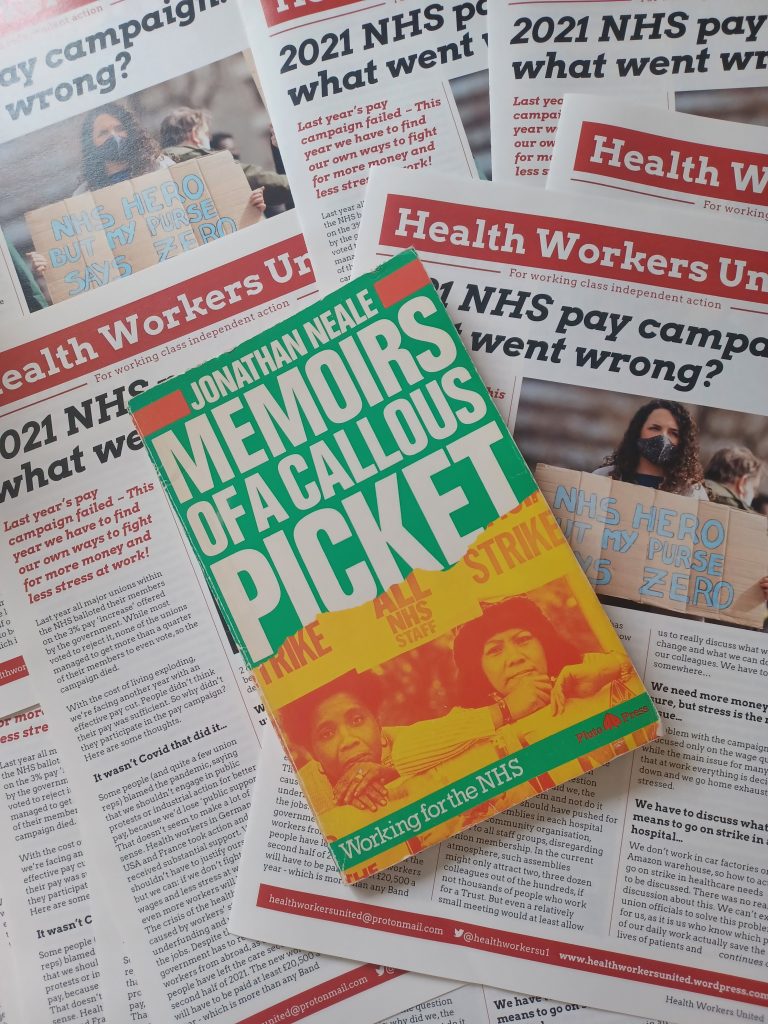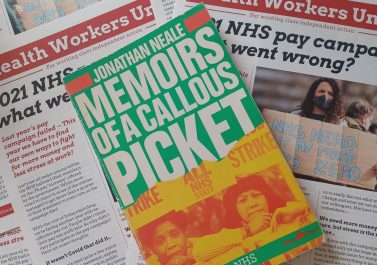
“You came to this work out of love and pride. You find yourself up to the elbows in some ungrateful old man’s shit.”
We reviewed Jonathan’s book while being involved in the publishing of a new book on current conditions and struggles in the NHS: ‘Sick of it all’. The ‘Sick of it all’ book’s Facebook page is here. Email us if you are interested in getting a copy or organising a book event. We will organise a book event together with Jonathan on the 9th of July 2022 in London, book your free ticket here.
——
A few of us now work in the behemoth that is the NHS, and while we were doing some background reading into historical healthcare struggles in the UK, we came across Jonathan Neale’s book, ‘Memoirs of a Callous Picket’. It is a short and readable book, full of useful and interesting information about the wider social and political context in which NHS nurses went on strike in 1982 – this was the biggest industrial action the NHS has ever seen, with nurses at the time demanding a 12% pay increase.
This seems like a million miles away from the situation we, as fellow hospital workers, currently find ourselves in. After all the recognition we got as essential workers during the pandemic, it still failed to materialise into any actual benefit. Last year’s pay offer was a measly 3% that translated into another annual pay cut when inflation was taken into account. The NHS pay campaign last year got nowhere near the mobilisation that would have been needed to get an actual pay rise, and chronic demoralisation is everywhere. How did we get from the biggest nurses strike in NHS history 30 years ago, to the point now where unions can’t even get more than 25% of their membership to come and vote in an indicative pay ballot?
As AngryWorkers, we’re interested in finding out. What can past struggles teach us about today’s situation? How might it be useful to compare the composition of the NHS workforce today with the past? What were the barriers then, and how were they overcome? Can we learn something to help us overcome the existing barriers to workers’ self-organisation within the NHS today?
In order to try and answer some of these questions, we first need an honest and critical reflection of the struggles we’re engaged in. This can be tricky. Often, we’re either ‘too close’ to things, or too far away to make objective assessments. Sometimes, the desire to present things favourably is a powerful driver, either to retain or recruit new members, for personal kudos, to save face. But then learning from these struggles and building a bigger collective knowledge within the working class becomes more difficult.
Neale’s book’s great strength is its ability to be honestly critical about the limitations, both objective and subjective, of tactics and structural constraints. It’s refreshing to read such a book, especially as there are hardly any inside accounts from working class militants anymore. Although he was in the SWP when he wrote this book, his descriptions, for example, of the contradictory positions of union reps and the individualising nature of ‘representation’, are pretty spot on and much clearer than what the traditional left produces nowadays. (He is no longer in the organisation.)
As workers in a big hospital, we know that it’s a microcosm of larger class society. Jonathan Neale knows it too, and the book opens by taking the reader on a tour of the hospital: who works there, what they do, and they relate to each other. It’s a fascinating insight into the complexities of healthcare in capitalism. The surgeons at the top, the cleaners at the bottom; the racist divisions in who does what job; the different banding levels and hierarchies that bleed into how you relate to your workmates; the alienation of doing a job that should involve the nurturing of human beings inside a system that makes it impossible.
“It can be two in the afternoon by the time the last patient is out of bed. Almost time for tea, and toilet, and starting them back to bed, and dinner and toilet. You miss your dinner, your back aches, there’s hardly time to sit down. Your day off you spend sleeping…The result is that patients don’t get what they need. The nurses start to hate the patients or just switch off inside…The ward is the scene of many little human tragedies. As a nurse, you survive by blanking out. In the process, you become a worse nurse. You blank out your feelings and your patients’ feelings. You start treating them as objects or children or ‘patients.’ Anything but adults coping with difficult problems.” (p.21-23)
Class struggle is a balance of objective and subjective forces and the author fleshes these out as he describes how the hospital works and how we, as workers, respond to that over time; how the social relations between workers and between workers and patients changes and under what circumstances. The effect of all this is to make the class struggle real and present, not just some theoretical imaginings. There are human actors and organisations involved, operating on individual or organisational and class solidarity levels at various times. The result is a real attempt at demystification of the process of workers’ struggle. It’s not about some great ‘organiser’ who applies the right methods and gets a ‘victory’, but a complex and often contradictory process.
We need more writing like Neale’s from the left: detailed and personal, at the same time as looking at struggles at various levels: what is happening in the wider political sphere? What are other groups of workers doing and how are they relating to each other? What is going on in the unions – and hospital management for that matter? What’s happening at the rank-and-file level? What kind of organisations and discussions are people involved in? How does this play out in the day-to-day? It’s only when workers start analysing their own struggles that they will be in the best position to fight. In AngryWorkers’ lingo, this is a classic workers’ enquiry. Neale and his counterparts in the hospital were somehow doing it: analysing the way decisions were made, weighing up the pros and cons of different strategies, having an eye to what other workers were doing and whether that changed the wider balance of forces and their own position within it.
“And of course, the sectional strikes did nothing to win the dispute. Most stewards running sectional strikes were only too well aware of that. They were just trying to keep something going inside the hospital while they figured out how to move the TUC…Nobody had an alternative to the TUC. There was no rank-and-file network in the hospitals that could move independently of the TUC.” (p.98)
In reading the book, we were always trying to relate these past experiences to our own as healthcare workers now. What has changed and what has stayed the same? The stuff that hasn’t changed is predictably depressing: surgeons are still at the top and cleaners are still at the bottom; racism is still rife; staff hierarchies are still alive and kicking which makes a united workforce difficult and a culture of bullying pretty much inevitable; the unions are still pretty useless and engage in the same kind of tactics e.g. pretending they’re up for a fight while doing nothing to mobilise for it and then blaming the workers’ lack of appetite for struggle on the fact that things came to a dead-end (see our write up of last year’s pay campaign!); the fact that payslips are still as indecipherable now as they were then! (resulting in probably massive amounts of wage theft that we don’t even notice); the constant attacks to services and conditions; and last but not least, the lack of rank-and-file (self-) organisation that increases the dependencies on the union and more so the case in the 80s, the TUC.
But while a lot of things have stayed the same, many things are different too.
In trying to explain the dynamics of the nursing strike, Neale writes about the fact that the feminist movement of the 1970s and early 80s had an impact on the militancy of the nurses. The 1982 strike, although a defeat, was proof that nurses had questioned their ‘feminine role’ as compliant caregivers and discovered themselves as workers. He draws a link between the movement for women’s liberation and these trade union struggles. There is some more evidence that, at least on the level of legal ‘equality’, things have changed through the struggle of women workers.
He writes that housekeepers and cleaners, who were predominantly female workers, were paid less than male porters. This has changed; now most of the so-called ‘unskilled’ workforce earns pretty much the same. This might well have happened by wage cuts of porter wages, rather than a rise of cleaners’ and housekeepers’ wages, though. He writes that there were 16 different pay grades for auxiliary workers, 18 for nurses and 41 for admin staff. This has been streamlined to seven or eight main pay grades in total. Another example are the nurses’ uniforms, which were still pretty ‘feminine’ back then and are now rather unisex. Also due to the increase in migration and changing attitudes, there are probably many more male nurses now than in 1982.
It is not a contradiction as such that while things might have become more equal between male and female workers, the atmosphere might have become more individualised at the same time, and the health sector workers more separated from the wider workforce. Neale describes how the hospital auxiliary workers’ wages were traditionally linked to pay deals enforced by rubbish collectors and other council workers. Workers were relating more to each other, comparing wage gains and industrial action. An example was when some militant actions by council workers resulted in a wave of partial strikes amongst auxiliary staff in hospitals in 1972-73, kicked off by a spontaneous walkout in Bristol. Since then, Labour and Tory governments alike have tried to break these links.
This is why trade union laws have become much more constricted: the solidarity strike, which was the main way class solidarity expressed itself in the 70s and early 80s has become a dim and distant memory. So it’s not too surprising that, aside from maybe pockets of outsourced hospital workers, rank-and-file activity on this kind of scale has pretty much dissipated too. There was a nationwide junior doctors strike back in 2016, the first in 40 years, but negotiations dragged on for four years and so by the end, only 28% of doctors voted in the referendum to accept the terms of the new contract, which fell far short of what was originally demanded.
The strike has a different significance in healthcare, what with patients’ lives potentially on the line. While the junior doctors’ strike didn’t lead to any more deaths, nurses I’ve had conversations with on the ward are reluctant to strike because they fear letting their patients down and risking their health. While nurses have overcome these fears and found ways around them in some more recent strikes (e.g. Northern Ireland, Germany, USA), the discussions about safer or alternative ways of striking are not yet very advanced in England. So we were interested in what Neale was writing about tactics and strategies in the 1982 strike.
Then, workers and unions engaged in so-called hospital occupations, when workers kept on working despite closure plans for the hospital. This primarily happened after the Labour Party got elected in 1974 and tried to enforce further cuts in social spending. At first glance, the occupations seem pretty radical, or at least more radical than petitions and symbolic protests. The author details several examples of hospital occupations in the mid-1970s, six in London alone, but also points out that they were often an expression of the fact that workers in the wider sector were not organised enough to oppose the cuts through strikes. It was left to the individual hospital to ‘fight it on their own’. Local authorities would at some point stop sending patients, and workers would be stranded. This perhaps merits a longer quote:
“In London, the crunch came over the Hounslow Hospital. This small hospital in West London was occupied for months and months. Finally, management came in with strong police protection. They pushed past the lone picket at the front. They forced sick and confused patients into taxis and bundled them off to other hospitals. The staff on the wards didn’t fight back. Partly they were astonished and partly they didn’t want to upset confused elderly patients with hand-to-hand fighting. (…) Management set to work with axes to break up the beds and wreck the wards so the hospital couldn’t be used again. Next day, all papers and the TV news carried pictures of the vandalised wards. If ever there was going to be a strike over the cuts in London, this was it. (…) Mass meetings at twelve hospitals voted to strike the next day. But only the West London Hospital voted for an all-out strike. The rest went for a one-day protest. There was an angry march to the area health authority meeting that day. Geoffrey Drain of NALGO was booed off the platform for refusing to make the strike official. (…) All over London, militants realised that occupations were useless without strike backing. At the next NUPE conference there was an attempt to call for an official strike in support of another occupied hospital: London’s Elizabeth Garret Anderson. The NUPE leadership refused to let it be discussed at the conference. The writing was on the wall.” (p.74)
But there were also smaller examples of successful resistance:
“Take, for example, the porters at St.Francis’s Hospital. In 1976, they faced the first cuts. Management closed two wards. They wanted to re-organise the catering rosters and get the porters to take on extra duties. The enraged porters decided not to cover for vacant posts. The filing clerk on nights had left and hadn’t been replaced. The night manager ordered three porters to get some files. One by one, they each refused and were sacked. One of them was the NUPE branch secretary. By morning, all the ancillaries were out on strike. In three days, management buckled and reinstated the men.” (p.77)
When it comes to the 1982 nurses’ strike, Neale gives us some valuable background: nurses hadn’t been out since 1974; the government had tried to split the hospital auxiliary workers from the disputes of manual council workers (the former would look to see what the latter had won and used this as the basis for their pay demands); the TUC played its own role of cutting hospital strikes off from ongoing disputes in the railways and instead, paraded the health workers through a series of largely ineffective one- or two-day strikes. This meant that the strikes took place in a situation of relative isolation. Still there are some interesting lessons, in particular when it comes to so-called ‘sectional strikes’, where instead of the whole workforce, only a certain department goes on strikes, which then affects the whole operation of the hospital:
“These had been a success in many areas already. Some hospitals had had sections out for twelve weeks. In most general hospitals, quite small sections can bring everything to a grinding halt. Stores, the laundry, the central sterile supplies department and the operating theatre are all crucial. The union collected a levy from all the members in the hospital. This made up the lost wages of the dozen or twenty strikers. Management usually had to agree to reduce the hospital to an accident and emergency basis. (…) The stewards recommended sectional strikes because they wanted to keep something going. (…) The sectional strikes tended to isolate hospital workers. After all, you can’t go and ask other people to strike in your support if you’re not on strike yourself. Unlike a real strike, you just don’t have a horde of people to go on flying pickets and talk to other workers.” (p.97)
Here we might have to see that the answer of the traditional left, which includes the author’s SWP, to any problem of working class struggle is: “Call the TUC to call for a general strike”. Which the TUC never does. Perhaps sectional strikes, if rotating and consciously coordinated by workers, could be a form of effective struggle, especially if they could be used to open up time and space for workers to create conscious bonds with other workers. Wage losses would be smaller, as not all workers are out at the same time, while even a smaller group of workers can cause a bigger impact. By using the time to reach out to other workers, it could avoid the trap that Neale mentions: the resentments of ‘striking for others’, passiveness of those not on strike etc.
Another interesting aspect of the nurses’ strike is that they became contradictory symbols for the wider class. On one side, they were the ‘angels’ that needed support, as they couldn’t go on an all-out strike, as this would endanger patients’ lives. On the other side, they were a massive national force that could, partially, focus the anger of workers in smaller workplaces and sectors that were suffering from the constant austerity attacks.
“Perhaps the most important reason people came out was that hospital workers actually had the confidence to ask them. Most workers on strike feel isolated and defensive. We stood up and told them that we were providing emergency cover because it was their mums and dads in that hospital. They’d have [italics] to strike to support us. We spent our working lives caring for people, with few thanks and little money. We felt the working class owed it to us to support us in our need.” (p.102)
Despite the various manoeuvres of the TUC to split strikes in transport from the nurses’ mobilisation, the national strike day on the 22nd of September 1982, “was the largest solidarity strike since 1926”.
So where are we now, and what insights might be useful to NHS workers going forward? AngryWorkers have contributed a couple of articles to a new book, ‘Sick of it all, Work, Inquiry and Struggle in the NHS’, that includes snapshots of the NHS from workers’ perspectives, as well as some analysis of healthcare in capitalism. Because we rated his book so much, we have invited Jonathan Neale to speak about his past experiences at the book launch in London. If you’re a healthcare worker, or interested in the workers’ struggles in the health and care sector, come along! We will be presenting the book, and some reflections from Neale, before having a Q&A and wider discussion about our current situation. The key question Neale raises in the book about strong and independent rank and file action is still the most pressing one, 50 years after this book was written. How do we make it a reality?
Join us on: Saturday 9th July at 3pm
Marchmont Community Centre, 62 Marchmont Street, London WC1N 1AB.
Please buy your free ticket here:



